I’ve always disliked mowing, knowing that my mower uses gasoline and disrupts the wildlife in my backyard. But recently, I read a statistic that truly made me want to turn in that noisy machine for good: using a gas-powered mower for one hour produces the same amount of pollution as driving a car 300 miles. What?!
Soon after this dour revelation, a friend sent me a photo of her newly established wildflower meadow, and all I could think was, I want one! Colorful blooms are much more inviting than a lawn that requires weekly mowing. So what is a wildflower meadow? Read on to find out, as well as to learn how to plant one!

What Is a Wildflower Meadow?

A wildflower meadow is simply a space filled with native flowers and grasses. In an attempt to recreate wild spaces for their own benefit as well as that of wildlife, many people cultivate wildflower meadows of varying sizes in their own yards.
Why plant a wildflower meadow?

As suggested above, one of the many reasons to plant a wildflower meadow is to reduce the amount of lawn you have to mow every week, saving you time and preventing the emission of pollutants. In fact, a wildflower meadow does exactly the opposite of polluting: the native plants sequester carbon, removing it from the air and storing it.
A wildflower meadow filled with colorful blooms and varying textures of foliage is also infinitely more beautiful than a monotonous lawn of mown grass. Add a walking path or a bench and you have the perfect place to relax and recenter yourself.
Those lovely blossoms benefit wildlife, too, serving as important habitat for pollinators like bees and butterflies. In addition, wildflower meadows provide food as well as shelter for other insects, birds, small mammals, and a host of other animals. Looking closer, the complex root systems also improve the soil, preventing runoff, creating irrigation channels, and distributing nutrients so that soil organisms, as well as plants, can thrive.
How to create a wildflower meadow
While a wildflower meadow requires less care than most gardens, it does take a bit of effort to create one, and a small amount of maintenance will be necessary to keep the meadow looking and performing its best.
1. Prepare the soil

First, make sure your chosen location receives at least six to eight hours of sunlight each day and has adequate drainage. It could be part of an empty field or a section of lawn or along a fence, driveway, patio, or woodlot.
Next, you need to prepare the site: most native wildflower seeds will germinate best in loose soil free of competing nonnative species. These ideal conditions can be achieved in a couple of different ways. Regardless of which option you choose, mowing the area as short as possible before you start may help facilitate the rest of the process.
- Till the soil. About six weeks before planting, till the area to remove all undesirable vegetation. Repeat the process every two to three weeks to destroy any newly germinated weed seeds. You might be able to get away with just two tilling sessions, but this increases the likelihood that some weed seeds might survive.
- Tarp it. Two or three months in advance, lay down thick black plastic sheeting (6 mm is recommended) over the entire area, overlapping any edges by about a foot. Weigh down the edges with soil, sandbags, bricks, large rocks, or other heavy objects, making sure the plastic is pulled tight so no sunlight or wind can get underneath. When you remove the plastic before planting, you should have bare soil to work with, as the plastic will have smothered all weeds and created a warm, inviting space for small critters to tunnel in, effectively cultivating the soil for you.
- Remove the sod. A quick but labor-intensive method is to remove the sod from the site. Use a spade for a small area or rent a sod cutter for a larger space. To ensure no weed seeds remain behind, you may want to till the area two or three weeks later or tarp it as described above for a minimum of three weeks.
2. Choose native flowers
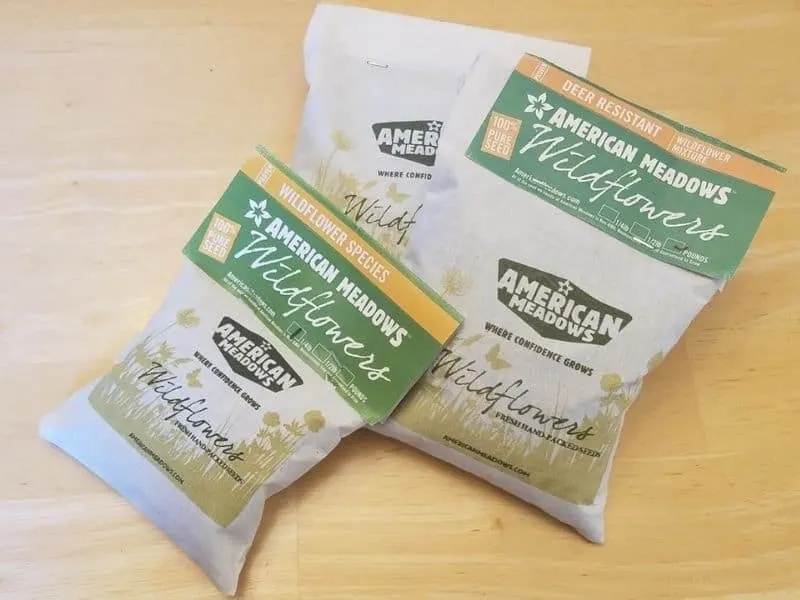
This step can happen before you prepare the soil or during the long waiting period in the middle of soil preparation. The best way to determine the ideal wildflower mix for your location is to contact a local expert, such as an extension agency, or a native seed company like American Meadows.
Of course, you can also do some independent research! You’ll want a good mix of species native to your specific area, including flowers, grasses, and sedges, to ensure a variety of colors and textures throughout the growing season. For example, some species recommended for my region in Virginia include the following:
Flowering forbs and legumes
- Aster (heath, New England, or smooth blue)
- Beardtongue (Appalachian or smooth)
- Black-eyed Susan
- Brown-eyed Susan
- Butterfly milkweed
- Columbine
- Coneflower (grey-headed, orange, or purple)
- Coreopsis (lanceleaf or plains)
- Goldenrod
- Partridge pea
- Wild bergamot
- Yarrow
Grasses and sedges
- Brown fox sedge
- Eastern gamma grass
- Indiangrass
- Little bluestem
- Purple top
- Side oats grama
- Virginia wild rye
Plant wildflowers
Fall is the best time to sow a wildflower meadow, though you can also plant in the spring. Plan on about four or five pounds of seed per acre, and consider mixing in some damp sand to help with distribution. For a large area, divide the site into smaller plots to make sowing more manageable. On a windless day, broadcast half of the seed while walking back and forth in one direction (e.g., east-west), then spread the remaining half walking the other direction (south-north). A mechanical seeder (like this one) will speed up the process, especially on large sites.
Use a lawn roller or the edge of a grading rake to tamp the seed into the soil and help hold it in place until it germinates. Finally, spread a thin layer of straw or mulch hay over the area for added protection and moisture retention. Supplemental irrigation, especially during dry spells, may help the seeds germinate and the seedlings establish themselves.
3. Maintain your meadow

Your new wildflower meadow will require the most care during its first year, as the plants become established, and all your hard work and patience will pay off starting the second year when the flowers begin to bloom in earnest.
Familiarize yourself with aggressive weed species and keep an eye out for them, removing any intruders before they set seed. You may want to mow midsummer at a height of four to six inches, which will chop off the tops of weeds while leaving most of the young, low-growing wildflowers. A string trimmer or scythe will be the least disruptive.
Ongoing maintenance once the meadow becomes established is minimal. Continue to watch for aggressive weeds, and provide some supplemental water during any periods of prolonged drought. Aside from that, you may want to mow (ideally to a height of six to eight inches) once per year in the late fall or early spring to prevent woody shrubs and trees from taking over. If you have a large meadow, mowing only one-third of it each year will leave the rest for wildlife habitat.
4. Enjoy the process
Remember that although you cultivate it initially, a wildflower meadow is not a garden but a wild space. Consider yourself a nurturer, encouraging the plants along and then stepping back to enjoy the process, because the meadow will change over time.
Are you ready to replace some gas-guzzling lawn with a vibrant wildflower meadow?
Books about creating wildflower meadows
There’s something special about being able to flip the pages of a book with in-depth information about your interest, as well as a lot of pictures. Here are a few books, if you like to actually have a book in hand while learning about planting a meadow.
Garden Wild: Wildflower Meadows, Prairie-Style Plantings, Rockeries, Ferneries, and other Sustainable Designs Inspired by Nature Sowing Beauty: Designing Flowering Meadows from Seed
Sowing Beauty: Designing Flowering Meadows from Seed Lawns into Meadows: Growing a Regenerative Landscape
Lawns into Meadows: Growing a Regenerative Landscape Mini Meadows: Grow a Little Patch of Colorful Flowers Anywhere around Your Yard
Mini Meadows: Grow a Little Patch of Colorful Flowers Anywhere around Your Yard Making a Wildflower Meadow
Making a Wildflower Meadow How to Make a Wildflower Meadow: Tried-and-Tested Techniques for New Garden Landscapes
How to Make a Wildflower Meadow: Tried-and-Tested Techniques for New Garden Landscapes
Pictures From The First Year Of A Meadow
Adriana here, adding to Serena’s thoughts. I planted a meadow last year and here are pictures from the first year of the meadow. BTW, growing a meadow has been an amazing experience for me. I LOVE walking down my driveaway (we have a long driveaway and the meadow is to the right side of it) and seeing what new species I can observe. I always go with my phone in hand for pictures and to use my Seek app to identify plants.
We bought 2lb of deer-resistant wildflower seed mix from American meadows (this is the exact mix we got) to which we added 1/4 pound of zinnia mixed seeds. Some of the flowers included in the American Meadows packages were red poppies, California poppies, lupines in blue and yellow, wild foxglove, bright red-and-yellow Gaillardia, white yarrow, blue pimpernel, coreopsis, blanket flower, blue and scarlet sage, and many more.

The first ones to bloom (at the end of May) were these tiny, adorable white blooming sweet alyssum flowers. It was so good to see flowers growing instead of weeds!
Soon after, the California poppies started to bloom (you can see a lonely one in the picture above).

Not long after, the marigolds came up. And you can see the zinnia leaves appearing: how exciting!

By the first week in June, the poppies exploded into beautiful bloom colors. I’ve never seen so many poppy colors. Before seeing this, I only knew about red and orange poppies. But we had white, bright pink, pale pink, burgundy, and pink with white borders poppies.

Here’s just a small sample of the colorful poppies.

On June 10, the first zinnia bloomed. And, of course, the poppies kept blooming!
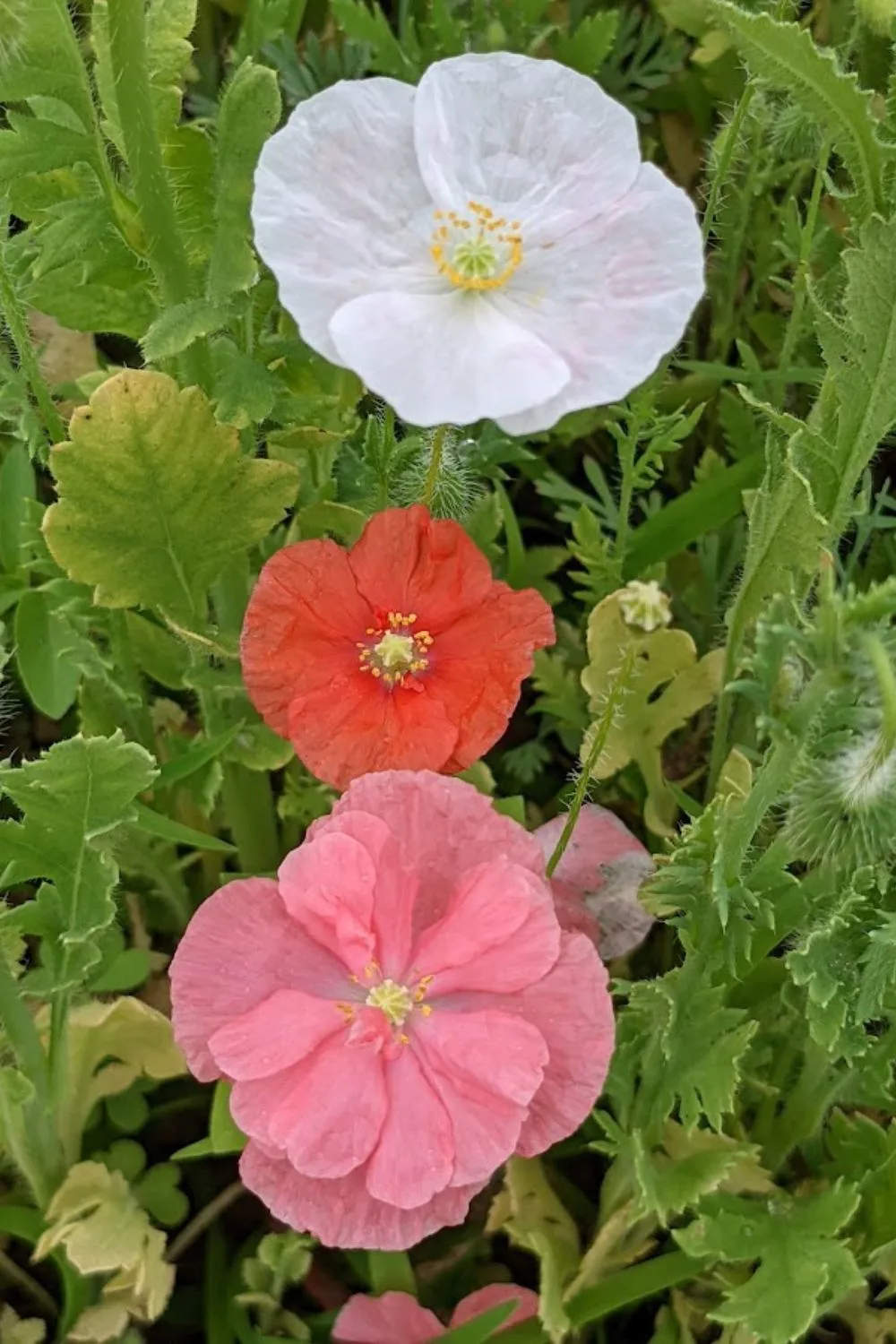
Here’s another picture of poppies: aren’t they gorgeous?

By the end of June, the zinnias were bringing up lots of blooms: s many colors! so many shapes! All LOVELY!

By mid-July, a few larkspur flowers bloomed, but the meadow started to feel the heat. Many of the plants were drying up, and for a while, it looked pretty dry and desolated.

These sunflowers were not part of the wildflower meadow seed mix, but we planted them at the bottom of our driveway, at the end of the meadow,l and July was their month to shine. They brought much happiness to our family and neighbors who drove by them.

In October, the zinnias shined! We cut hundreds of them to give away to friends and strangers alike.

The first year of our wildflower meadow ended on November 3rd, after an early freeze. The zinnias gave us one last show, and it was beautiful!
Second Year Meadow Flowers
In the second way of our meadow, the pants were almost completely different. I knew the makeup of the meadow would change for the first 3 years, as biennials start blooming and perennials are getting more established.
But I was in for a big surprise. We had many plants I didn’t know were in the mix (and probably weren’t), but nonetheless, we loved them all (well, almost all, as we weren’t able to remove weeds as they ap[peared, and we ended up with a huge wild meadow.
Here are some of the plants we observed this year in the meadow.

The first plant to appear this year was the bee balm, about mid-May. There was a lot of it. And… I wasn’t fully familiar with it, so I wasn’t 100% sure what it was. The plant ID app called it several different things, so we had to be patient and make sure it was actually a plant we wanted to keep in the meadow.

A few days later, we had a few blooms of Sweet William. They were a very pretty and fragrant surprise :).
But for a while after this, not much happened in the flower meadow. A few poppies (both orange and red) came up but compared with the thousands the previous year, it was sad.

About a month later, in the second half of June, this beauty came up. I’ve never seen one before and didn’t know that it was. Turns out it is a fern-leaf yarrow. Beautiful flower and it smells good too!

Over the next few days, several flowers popped up. None of them in big numbers. But nonetheless beautiful. Here are a few snapshots from the meadow in the latter part of June.

So pretty! I love the pink and white combination of this Sweet William.
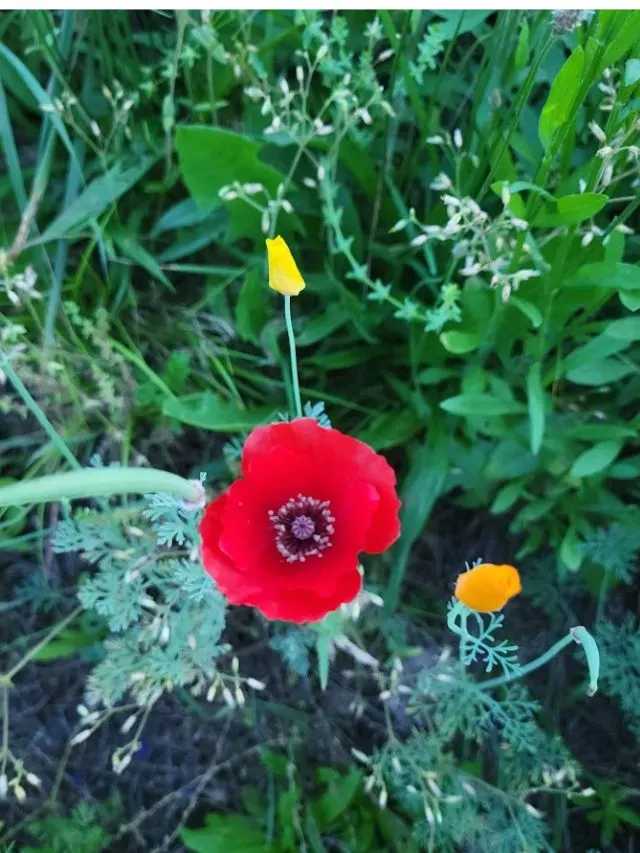
I love the combination of red and yellow poppies. It was a nice color pop in the garden.
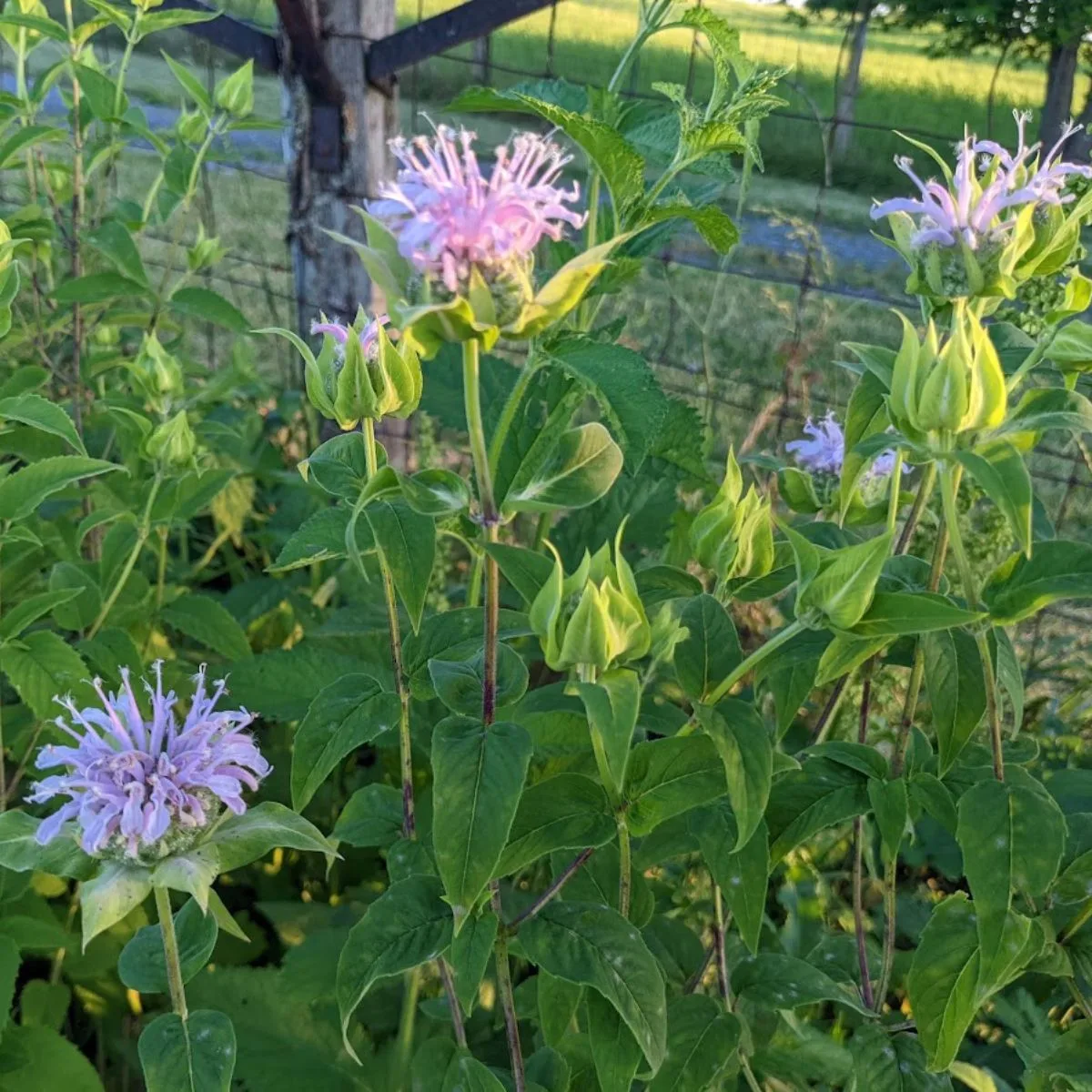
The first of many bee balm flowers bloomed on June17th. It was exciting to see that all those tall plants turned out to be monarda and not a weed.

We had another surprise the next day: a baby deer hiding in the bushy flowers. We called her Dottie and saw her for a few days, just resting between the flowers.

Another view from the flower field this month. The white flowers are fleabane daisies, and we have a lot of them!

Here’s how the meadow looks the first week of July. Beautiful white fleabane daisies, gorgeous yellow fern leaf yarrow, and purple monarda flowers are a beautiful sight to be seen.

A bunch of weeds also made their way into the flower patch. We had lots of ribwort plantain, but I liked their spikes, so I let them be.
I’ll add more pictures as time goes on. This wildflower meadow is fascinating to watch develop.
Wildflower meadow pictures for inspiration

What a gorgeous view to wake up to!

If you have land, planting a meadow would give you the perfect place to roam around and clear your head and enjoy nature.
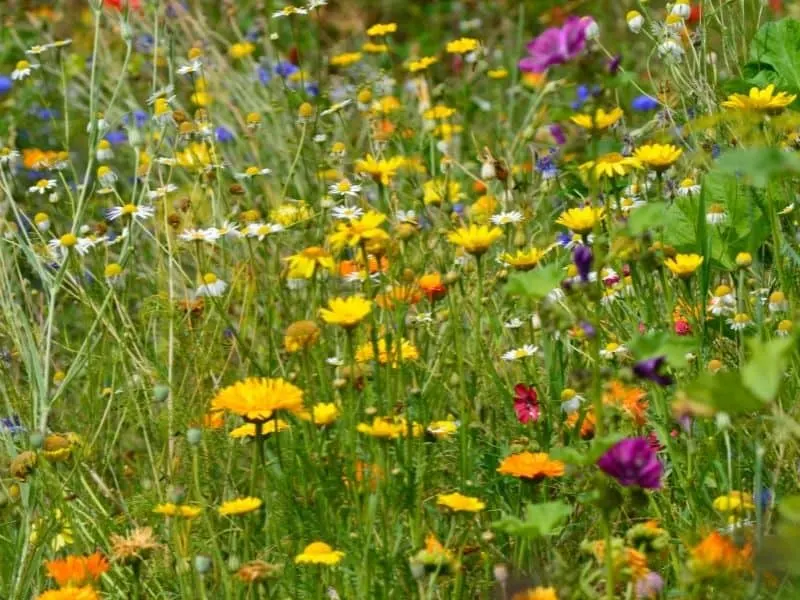
I adore yellow flowers in my garden: they make me smile every single time! this meadow has an abundance of yellow and orange flowers, perfect for a frolic in nature.

I hope you’ve been inspired to look into creating your own meadow. It doesn’t have to be a large hill or a huge garden. Even a tiny patch of wildflowers can give you a taste of the beauty of a meadow.
And if you just don’t have time or space for a wildflower meadow right now, take a car ride and drive by some of the meadows in your area. You’ll be refreshed and invigorated.

Serena Manickam is a freelance editor and writer and sustainable market gardener in rural Virginia. She holds a BA in environmental science and runs Fairydiddle Farm, a small market garden in which she grows no-spray produce and herbs to sell at a local farmer’s market.












Backyard Gazebo Ideas: 5 Fun Ways To Spruce Up Your Outdoor Space
Monday 21st of November 2022
[…] Because most outdoor gazebos are lightweight, they are easy to transport on a trailer and can be set up just about anywhere such as on a beach or in a meadow of wildflowers. […]
ROSE
Saturday 23rd of July 2022
I CONVERTED ONE PARKING SPACE INTO A WILDFLOWER PATCH AND IT TOOK 2 YEARS TO GET BEAUTIFUL FLOWERS TO GROW. MY POLLINATORS LOVE THIS LITTLE FLOWERGARDEN.
6 Landscaping Ideas Around Septic Tank Areas
Saturday 16th of April 2022
[…] turning the area around your septic tank into a wildflower meadow or pollinator garden. Native wildflowers attract bees, butterflies, hummingbirds, songbirds, and […]
Nebraska Native Plants List: 18 Stunning Flowers For Your Garden
Wednesday 22nd of September 2021
[…] flowers are great for prairie or meadow plantings. They bloom for weeks from early to late summer and they are also deer and rabbit tolerant. This is […]
Ohio Native Plants List - 10 Plants You'll Love In Your Garden
Thursday 8th of July 2021
[…] and is fun to watch the transformation. Low maintenance White Trillium is the perfect addition to wildflower gardens. Trilliums go dormant in the summer so plant them in partial to full shade in rich moist […]